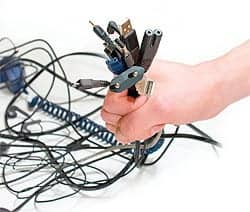
The world of wireless networking often resembles a murky lake. The water may be calm, but unseen, tangled weeds lie just under the surface. Even biomeds who would rather be handling a screwdriver or soldering gun now must dive into that water, whether they want to or not.
According to Rick Hampton, wireless communications manager at Boston-based Partners HealthCare System, any time you are talking about wireless, you are talking about radio. The first radio systems replaced the wired telegraph system and were called “wireless” because they did not require the many miles of wires strung between telegraph poles; “radio” was the term that later came into use. Albert Einstein, when once asked to explain how radio worked, replied, tongue in cheek, “You see, wire telegraph is a kind of a very, very long cat. You pull his tail in New York and his head is meowing in Los Angeles. Do you understand this? And radio operates exactly the same way: you send signals here, they receive them there. The only difference is that there is no cat.”
And in today’s hospital setting, there are no visible wires, but plenty of high technology. Medical telemetry, smart pumps, drug delivery systems, and automatic data transfer between vital-signs machines are all part of the new technology trends that require wireless solutions. Siemens Healthcare has received FDA 510(k) market clearance for the Ysio, a new generation digital radiography system with a wireless detector (wi-D). The Ysio is designed to foster short examination times that improve daily patient throughput. Even though items such as these have been on the market for a while, many hospitals have not had the money or manpower to get them implemented. When they do, however, biomeds need to be ready.
While it depends on the hospital, many departments are also implementing radio frequency identification (RFID) systems to help locate equipment and ensure PMs are done on time.
“Through RFID, you want to be able to triangulate the machinery, find it, perform your repair, or perform your PM,” says Wes Pool, CBET, clinical engineering technician for Philadelphia-based Aramark Healthcare CTS division. “Now, in some of the new nurse call systems, they are even triangulating nurses through an RFID badge they will wear, or a transponder clipped to the uniform. That way they can find nurses, see where they have been, see if they are in the right room, or if they are on the wrong floor. If you have a good idea through triangulation about where a person is, you can automatically send that call to the antenna he or she is standing under.”
Addressing Wireless Problems
When it comes to wireless difficulties, Hampton harkens back to the Sherlock Holmes character that famously advised to reduce the number of possibilities, and whatever is left—no matter how incredible—is the right answer.
“That is what you have to do with a lot of these wireless problems,” Hampton says. “You have to keep an open mind and literally believe that anything can be the problem. You must systematically go through and rule out things that are truly not the cause until you arrive at that true answer. It is likely that what you thought was the root cause is actually not the source of the problem.”
At some point in the troubleshooting process, the vendors of the various equipment will have to be brought together to jointly solve the problem. “Sometimes you need them to work together to identify the root cause using tools and techniques not available to you,” Hampton says. “Once the root cause is identified, then they must work together to find an equitable means of fixing the problem. It’s important to remind them that no one intends for different systems to adversely affect one another, so while no one entity may be at fault, everyone must share in the responsibility and work together to resolve the issues.”
Fortunately, equipment makers are heeding biomed concerns, and Pool believes that wireless systems are safer as a result. “From the beginning, we always thought that putting anything on a wireless system was going to be susceptible to corruption or viruses,” Pool says. “I really think the medical equipment manufacturers have been working diligently to make sure that they still keep their devices very safe and protected. The safeguards they have put in place have been relatively successful, with next to no issues when riding on a wireless system.”
Even with the added safety, Pool admits that things get complex quickly by virtue of the fact that so many systems are working together. The nurse call system, telephone, integration software, wireless system, and IT servers are all interconnected, and some kind of data failure across the wireless network is possible.
“You have to go in checking all those systems, trying to divide and conquer and find out where the issue is,” Pool says. “Sometimes that can be the hardest part, just trying to find which one of the subsystems is having the error, then fixing it so that it can work with all of the others. It has grown into such a great infrastructure, and you have got to find which component is not holding up. Know your systems well and learn over time. Sometimes the system will tell you which system is not working, and that’s always nice.”
All About Expectations
The evolution of wireless technology has overwhelmingly been geared toward consumer applications, with cell phones, text messages, and e-mail counted on by millions worldwide. The gadgets are so common that many view the devices as indispensable, and the IT industry mirrors this overall attitude.
“People expect to make a phone call anywhere and anytime they please, and they think they should be able to make similar connections to medical devices and things should work,” Hampton says. “The problem is the vast majority of people fail to understand the technical ramifications of the basic technology, so they don’t know its failure points. They don’t know how much the technology can bear.”
Citing an example, Hampton says, “A couple of years ago, we had a well-meaning individual approach our senior staff, stating they were wasting money by pulling any wires for networked systems in a building under construction, based on a press release he’d read about a new product that was to make wireless much more efficient. After explaining the technical fallacies of the gentleman’s logic, the project proceeded as originally intended. Soon thereafter, both the revolutionary new technology, and the company that developed it, disappeared from the market.”
Another problem, according to Hampton, is that many wireless networking features promised by the IT industry and network innovators simply do not work. “While these features might work in the confines of a development lab or small retail space, they often don’t scale well in a large health care enterprise,” Hampton says. “We are seeing false indications of problems that we know we don’t have. Conversely, we are having problems that aren’t detected. Other hospitals have seen the same issues.”
For biomeds looking to avoid problems, Hampton advises to keep options open, strive to understand new technologies, and realize that at some point you are going to have to go back in, lift ceiling tiles, and pull wires in walls.
Hampton also recommends clinical engineering and IT departments begin learning about IEC 80001, an international standard that addresses the risk management activities needed to safely connect medical devices to IT LANs. Due to be ratified later this year, the standard will also include technical reports describing how to identify and mitigate risks associated with wireless technologies, for which Hampton has been a significant contributor, along with other experts in the field.
“We believe the processes described by this standard will be key for hospitals to safely use wireless technologies with medical devices,” Hampton says. “There has been significant input from manufacturers and regulatory agencies from around the world. While the standard will be published as voluntary in nature, we believe it will become recognized by regulators and others as a way to ensure hospitals can maintain medical device safety.”
Expanding Knowledge
Three years ago, Pool had a chance to work with builders on a new 145,000-square-foot hospital (see the June 2009 cover profile in 24×7). As a clinical engineering technician for Philadelphia-based Aramark Healthcare CTS division, Pool helped McCune Brooks Regional Hospital (MBRH) in Carthage, Mo, coordinate the enormous job of replacing the 100-year-old MBRH with a new facility.
Working with builders required knowledge of current wireless technology and a prognosticator’s sixth sense about what might be required in the future. Ultimately, builders installed a communication backbone that could easily handle central monitoring, wireless systems, and countless medical devices—all with the potential for expansion.
It is the expansion—particularly into areas normally reserved for IT—that Pool tried to predict. And to deal with the new twists that are sure to come, Pool believes biomeds should be cross-trained, not only as regular biomedical equipment technicians, but in the IT world as well. “You should have basic networking skills to become a biomed,” Pool says. “You should know some networking troubleshooting and have an operational idea of how it all works.”
As hospitals connect more medical devices to the IT network, Hampton points out that the network inevitably becomes a component of the medical devices. As a result, he agrees that biomeds need to be involved in the construction, maintenance, and operation of those systems.
“In spite of claims to the contrary, most IT companies have no idea how to deal with the complexities of ensuring medical devices continue to be safe and effective when connected on shared networks,” Hampton says. “They quickly point out they are not medical device manufacturers, focus only on connectivity, and leave the rest to the hospitals to figure out. Similarly, many smaller medical device manufacturers who have never before dealt with networks are suddenly being pushed to provide network connectivity, and their lack of expertise shows. The biomedical engineering community and the IT community must come together and figure out how to overcome these issues.”
In recognition of these concerns, the Association for the Advancement of Medical Instrumentation, the American College of Clinical Engineering, and the Healthcare Information and Management Systems Society organizations agreed 2 years ago to work together. The resulting clinical engineering/IT, or CE-IT, community is now collaborating to better understand the many issues surrounding the continued integration of IT and clinical engineering.
“The boundary is definitely blurring, and some hospitals have merged those departments to address the issues,” Hampton says. “I and others have talked about the need for a hybrid position between those two departments, and my position is one example. I report to both the director in IT and the director in biomed, so I literally straddle that fence every day. Bridging both the IT and medical device worlds, I can easily see the interdependencies between systems that a clinical engineering and IT person may have trouble communicating to each other. As the medical and IT systems become more intertwined, I believe the value of hybrid CE-IT positions will become more apparent.”
If clinical/biomedical engineers are asked to straddle the wireless fence, they also need to understand how to define wireless and how it pertains to their work.
“Remember that wireless is not ‘wire-less,’ but less wire,” Hampton says. “You still must pull a bunch of wires to place wireless access points or cables, you still have to run wires and fibers to add switches and controllers. There is probably as much equipment in the background for the wireless system if not more than a wired system. Also, some new technologies may not be compatible with any of the current infrastructure systems available.”
And just because you call it “wireless” does not mean money is being saved. Instead, wireless should be viewed as a “renewable resource with finite capacity,” since resources must be shared with different applications in the building.
“You are sharing it with your coworkers and neighbors next door,” Hampton says. “You’re sharing it with the guests that come in off the street. Unlike a wired system, where you can dedicate bandwidth or capacity based on the number of wires you pull, there is only so much time that a wireless system can spend sending data to you and someone else. You are sharing that airspace in different time and frequency slots.”
Greg Thompson is a contributing writer for 24×7. For more information, contact .





